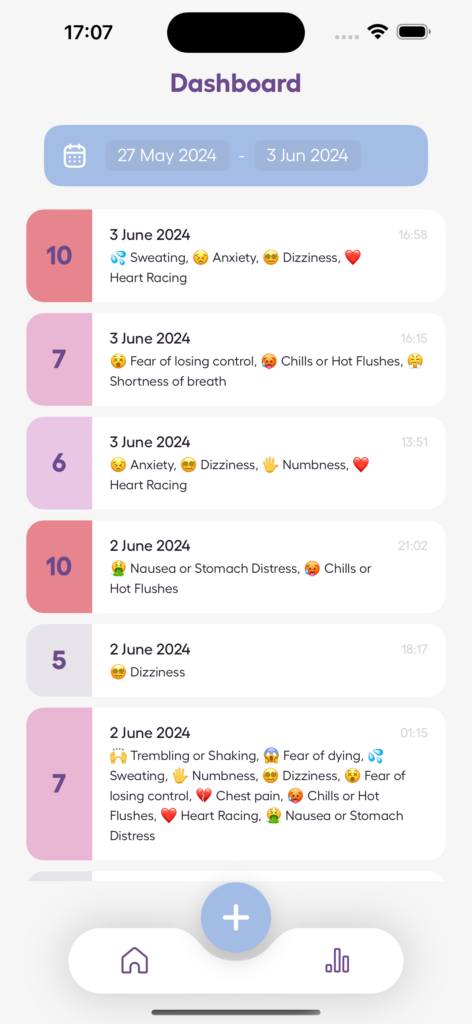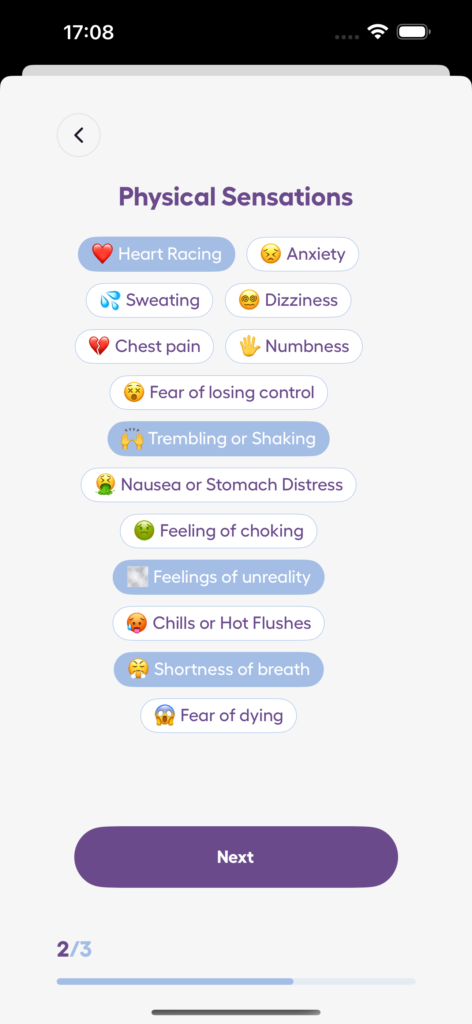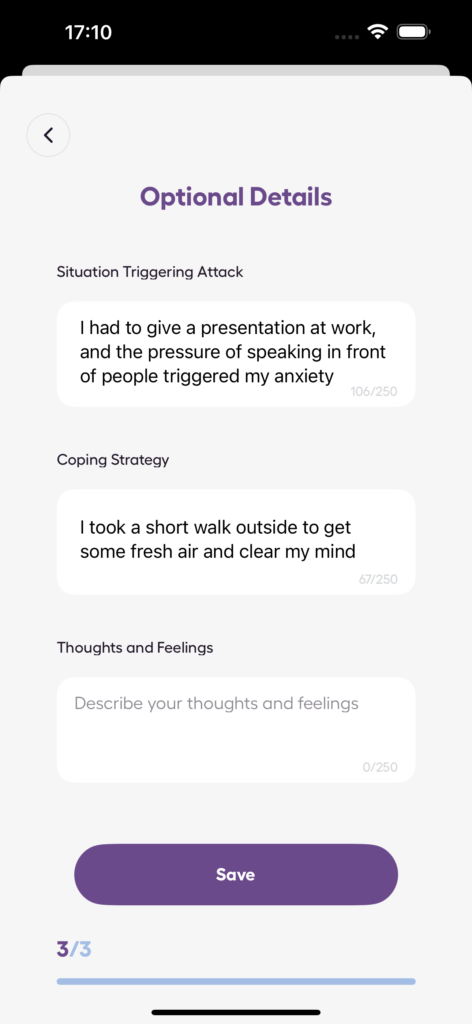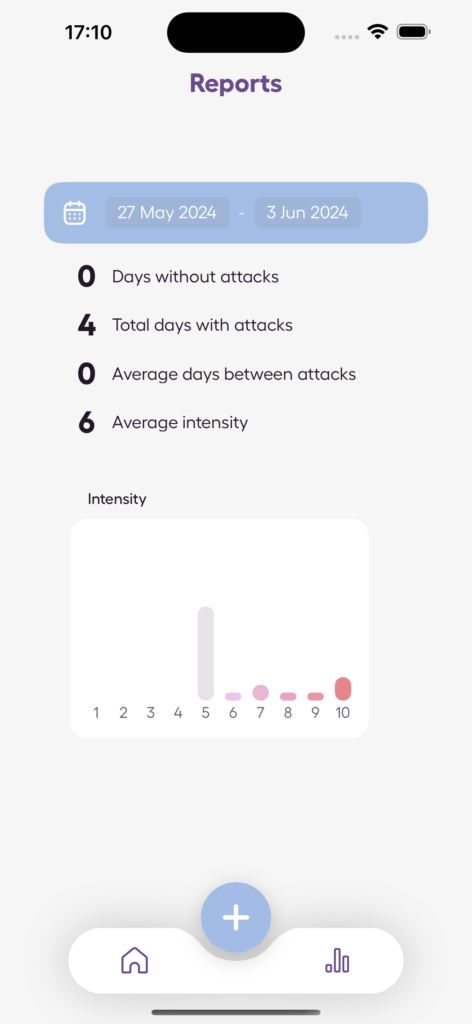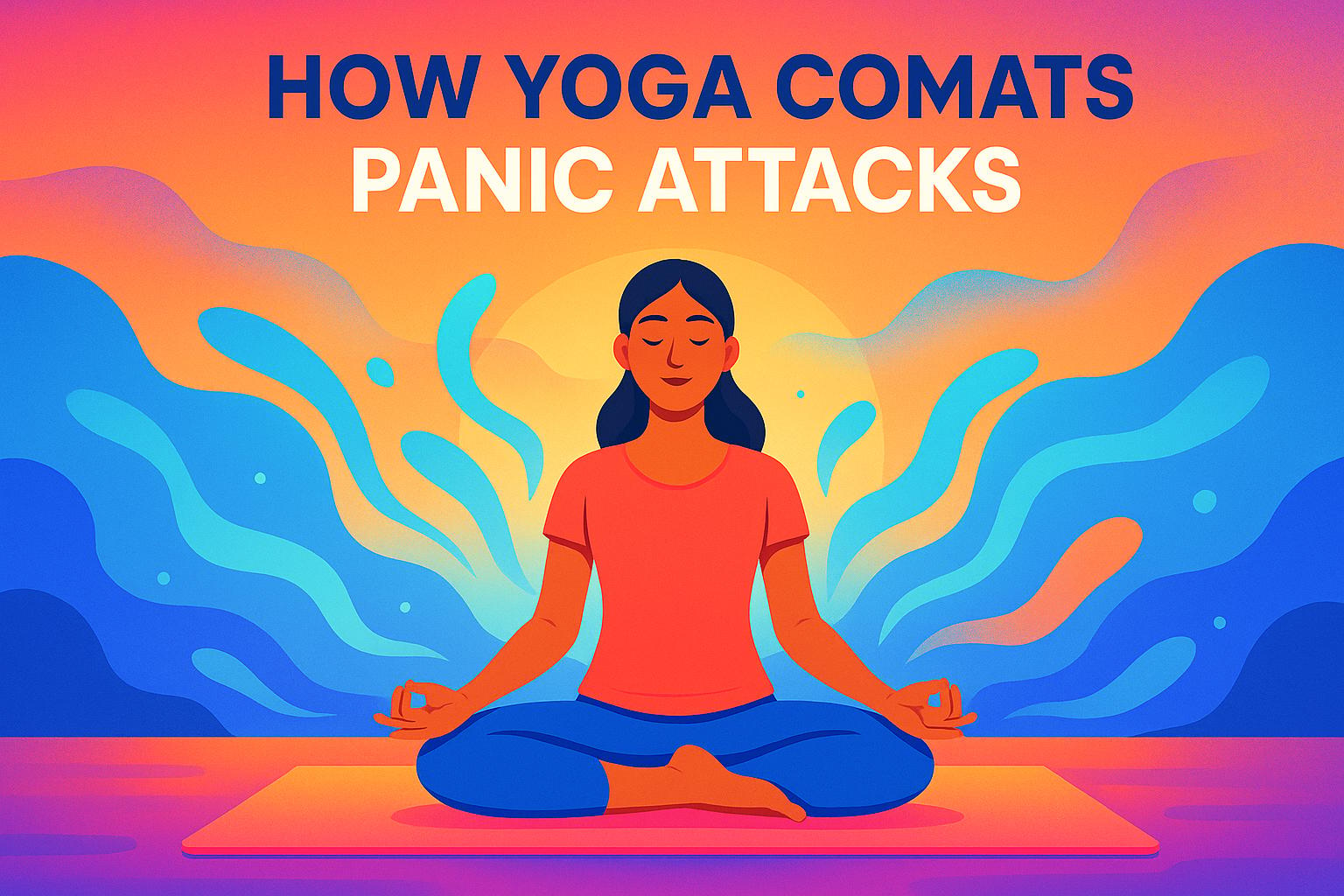CBT (Cognitive Behavioral Therapy) is a proven method for reducing the frequency and severity of panic attacks. It works by helping you recognize and change negative thought patterns, face fears gradually, and manage physical symptoms of anxiety. Here’s how CBT helps:
- Cognitive Restructuring: Identifies and replaces unhelpful thoughts with balanced ones.
- Exposure Therapy: Gradually confronts feared situations to reduce avoidance.
- Relaxation Techniques: Methods like deep breathing and muscle relaxation ease physical tension.
Tools like the Anxiety Journal app can track your anxiety patterns and complement therapy, making it easier to apply these strategies in daily life. With regular practice and professional guidance, CBT provides practical skills to regain control and prevent future panic attacks.
Panic Attacks and CBT Basics
Defining Panic Attacks
A panic attack is a sudden wave of intense fear or discomfort that peaks within minutes. These episodes can feel overwhelming, triggering both physical and emotional reactions that interfere with everyday life.
Here’s a breakdown of the common symptoms:
| Physical Symptoms | Emotional/Mental Symptoms |
|---|---|
| Rapid heartbeat or trouble breathing | Fear of losing control |
| Sweating or shaking | Feeling of impending doom |
| Chest pain or nausea | Extreme anxiety or detachment |
These symptoms can make even routine situations feel unbearable. Recognizing these signs is the first step to addressing them, and this is where CBT comes into play.
Overview of CBT
Once the nature of panic attacks is clear, it’s important to understand how CBT works to tackle their underlying causes. CBT uses structured methods like cognitive restructuring, exposure therapy, and relaxation techniques to address the thoughts, actions, and physical responses that contribute to panic attacks.
The therapy focuses on three main areas:
| CBT Component | Purpose | Outcome |
|---|---|---|
| Cognitive Restructuring | Identifies and challenges negative thoughts | Encourages more balanced thinking |
| Exposure Therapy | Gradually confronts feared situations | Reduces avoidance and builds confidence |
| Relaxation Techniques | Helps manage physical symptoms | Provides practical ways to cope |
Studies show that CBT can greatly reduce how often and how severely panic attacks occur. Tools like the Anxiety Journal app can complement therapy by tracking symptoms and spotting patterns, helping to maintain progress over time.
CBT empowers individuals with skills they can use on their own, breaking the cycle of fear, avoidance, and physical distress. This approach helps people regain control and confidence in their daily lives.
Effective CBT Techniques for Panic Attack Prevention
Relaxation Techniques
Techniques like diaphragmatic breathing and progressive muscle relaxation are key CBT methods for managing panic attacks. Progressive Muscle Relaxation focuses on recognizing and easing physical tension by systematically tensing and relaxing different muscle groups.
Diaphragmatic Breathing helps regulate breathing, counteracts hyperventilation, and promotes a calming effect on the body. Here’s how to practice it:
| Phase | Action | Purpose |
|---|---|---|
| Inhale | Breathe deeply through your nose for 4 counts | Activates the calming parasympathetic system |
| Hold | Hold your breath for 2 counts | Stabilizes breathing and reduces anxiety |
| Exhale | Slowly release breath through your mouth for 4 counts | Relieves physical tension |
Exposure Therapy
Exposure therapy uses a step-by-step approach to gradually face anxiety triggers, starting with less intense situations and moving to more challenging ones. This method helps individuals build resilience and confidence over time.
| Exposure Level | Example Activity | Expected Outcome |
|---|---|---|
| Mild to Moderate | Thinking about or visiting quieter spaces | Builds initial awareness and confidence |
| Advanced | Navigating crowded or busy environments | Strengthens coping mechanisms |
Cognitive Restructuring
Cognitive restructuring works by addressing and rethinking the thoughts that fuel panic. This technique helps individuals identify and replace unhelpful beliefs with more manageable perspectives.
"When individuals learn to reframe thoughts like ‘I’m going to have a heart attack’ to ‘These are anxiety symptoms I can manage with my breathing techniques,’ they gain more control over their panic response".
Apps like Anxiety Journal can assist in tracking progress and identifying which methods are most effective in specific scenarios. By targeting the physical, behavioral, and mental aspects of anxiety, these techniques offer a well-rounded approach to managing panic attacks.
Consistent practice of these strategies in everyday life is essential for maintaining long-term control over panic attacks.
Applying CBT Strategies in Daily Life
Setting Goals
Creating SMART goals helps make CBT techniques practical and trackable. Instead of vague aims like "reduce anxiety", set clear objectives such as: "Practice diaphragmatic breathing twice daily for 10 minutes over the next 30 days".
| Goal Component | Example | Purpose |
|---|---|---|
| Short-term | Complete 3 thought-challenging worksheets weekly | Build steady habits |
| Medium-term | Decrease panic attack frequency by 50% in 3 months | Measure progress |
| Long-term | Handle previously stressful situations without panic | Strengthen long-term coping skills |
Using CBT Exercises
Think of CBT exercises as part of your daily routine, much like going to the gym. For example, use diaphragmatic breathing during your day to stay grounded.
"CBT helps prevent anxiety attacks by addressing root causes through cognitive and behavioral changes".
A key tool in CBT is thought-challenging worksheets, which guide you to record, evaluate, and reshape negative thoughts. This process is central to cognitive restructuring:
| Step | Action | Benefit |
|---|---|---|
| Identify | Write down negative thoughts as they arise | Brings awareness to thought patterns |
| Analyze | Assess evidence for and against the thought | Promotes balanced thinking |
| Reframe | Replace with realistic, constructive alternatives | Encourages healthier mental habits |
Apps like Anxiety Journal can complement your CBT routine by tracking your progress and spotting trends in your anxiety triggers. Features like logging panic attacks and anxiety levels provide insights that can shape your approach.
To stay consistent, schedule specific times for practice. Mornings can be ideal for relaxation techniques, while evenings are great for reflecting and preparing for restful sleep. These regular practices create a strong foundation for managing anxiety and can be enhanced with tools like the Anxiety Journal.
sbb-itb-b1dedcc
How to Stop a Panic Attack With CBT
Enhancing CBT with Tools
Digital tools can play a crucial role in improving CBT by allowing users to systematically track their anxiety patterns. These tools act as a helpful link between therapy sessions, ensuring consistent use of CBT techniques.
Anxiety Journal: Tracking Panic Attacks
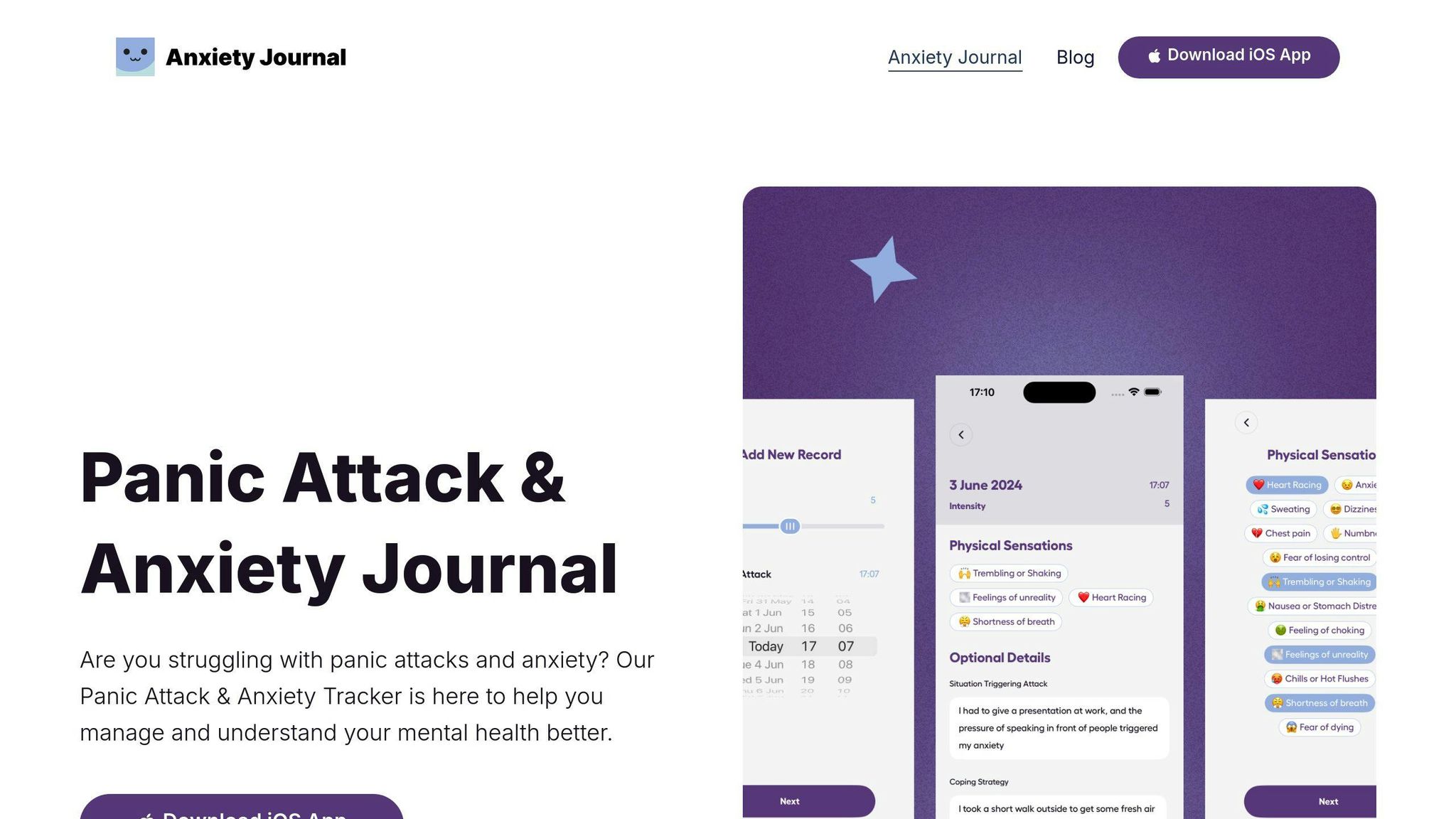
The Anxiety Journal app supports CBT by offering detailed panic attack tracking features. It helps users uncover triggers and patterns that might otherwise go unnoticed, thanks to its structured approach.
| Feature | How It Helps with CBT | Use in Therapy |
|---|---|---|
| Detailed Attack Log | Highlights recurring triggers | Assists in exposure therapy planning |
| Stress Level Tracking | Tracks changes over time | Helps fine-tune CBT approaches |
| Anxiety Tests | Offers measurable insights | Aids in setting therapy goals |
With this app, users can log essential details about their panic attacks – like triggers, symptoms, and coping methods. These records provide valuable insights that can guide therapy, especially in exercises like cognitive restructuring and exposure therapy.
The app’s privacy-first design encourages users to document their experiences honestly. This data not only helps users understand their anxiety better but also enables therapists to customize CBT strategies for more effective results.
Conclusion: Using CBT for a Calmer Life
CBT helps prevent panic attacks by combining methods like cognitive restructuring, exposure therapy, and relaxation exercises. These structured techniques give individuals the tools to tackle anxiety from different perspectives.
By learning to identify and challenge negative thought patterns and gradually confronting feared situations, people can gain more control over their anxiety and build resilience against future panic attacks.
To get the most out of CBT, focus on these key strategies:
| Strategy | Benefit | How to Apply |
|---|---|---|
| Regular Practice | Develops automatic skills | Incorporate daily CBT exercises |
| Progress Tracking | Offers measurable insights | Use tools like Anxiety Journal |
| Professional Support | Ensures proper guidance | Attend regular therapy sessions |
Digital tools such as Anxiety Journal can make CBT even more effective by helping you track your progress and spot patterns in your anxiety.
Consistency and patience are crucial. By sticking to these techniques and keeping detailed records of your experiences, you’ll strengthen your coping skills and build confidence in managing anxiety. With steady effort and the right resources, CBT can help you break free from the grip of panic attacks.


